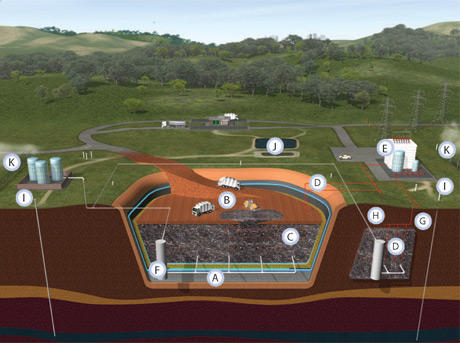Whatever waste is not recycled or reused has to go somewhere and it usually ends up in landfill sites like this one. Landfill sites can be created from the void made by quarrying or may form part of a land reclamation scheme.

A) To prepare the land before waste is deposited, several layers of linings are installed to seal up the base. Before we can begin to deposit waste, this process has to be verified independently for quality assurance. The process is as follows:
- First a regulating layer is laid down to smooth out the surface.
- A layer of clay is then put down to provide an excellent impermeable material that helps to prevent liquid from escaping.
- The third layer is a plastic liner.
- Geotextile is then placed over the plastic.
- A fifth layer of gravel is then installed.
- A layer of geotextile is the final stage of preparing the base.
B) Waste from the local area, maybe even from your bin, is brought to the site and tipped into the specially created cells. A compactor rolls over the waste to squash it into the hole to fill the space efficiently and to create a level surface.
C) Each cell is built up with waste stage by stage. At the end of each stage, it is covered with inert soils or a special matting that helps to prevent odours and keeps the waste in place until more waste can be placed on top to complete the cell.
D) Gas extraction wells are inserted into the cell to allow the gases that are created as the waste breaks down to be captured to generate electricity.
E) The gases are pumped to a turbine house where they generate electricity for the National Grid.
F) When water falls onto site it runs through the waste and collects solids and liquid. This liquid is called leachate. Leachate runs to the bottom of the cells where it is collected in a sump and pumped to storage tanks before it is taken off site to be treated before disposal
G) Each cell is filled with waste until it reaches a certain agreed level. Then the area is capped with a permanent plastic cover before we begin work to restore the land.
H) Restoration involves creating several layers above the waste to seal in what is below and protect what will grow above using a combination of high tech linings, subsoils and topsoils. The restored land will encourage wildflowers and a variety of other wildlife to the area.
I) Monitoring bore holes are located on and off site to allow us to ensure the quality of ground water in the vicinity of the site.
J) Surface water ponds can be found on the site. As surface water runs off the landfill site it is collected in the ponds to allow any soil particles that may have been collected in the process to settle before the water is allowed to discharge off site.
K) Around the perimeter of the site we have a de-odourising system installed along the fence. This helps to capture airborne odours and neutralize them before they leave the site. If you happen to be at the perimeter of the site and you see what looks like steam escaping from the fence, don’t be alarmed. What you can see is a very clever air freshener!

